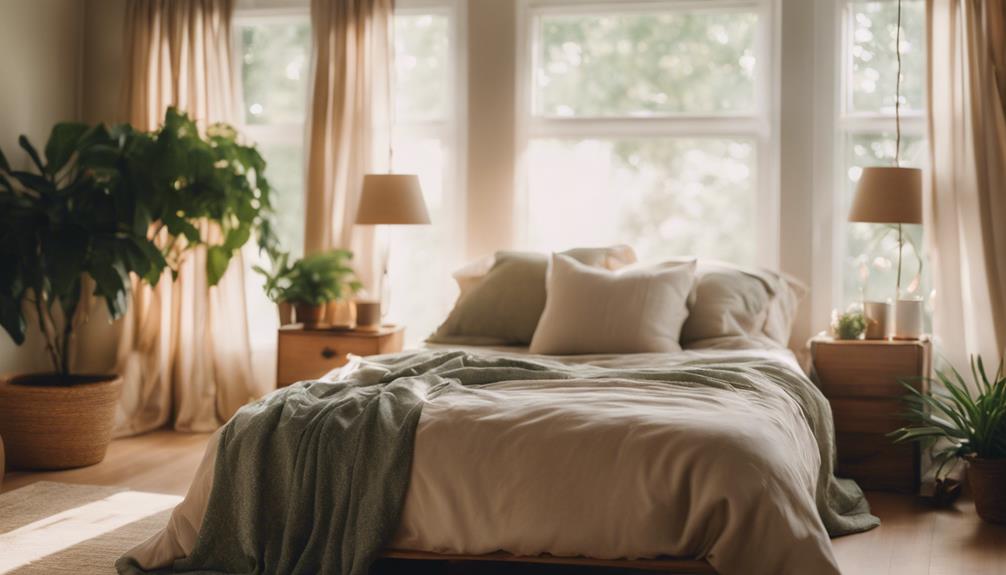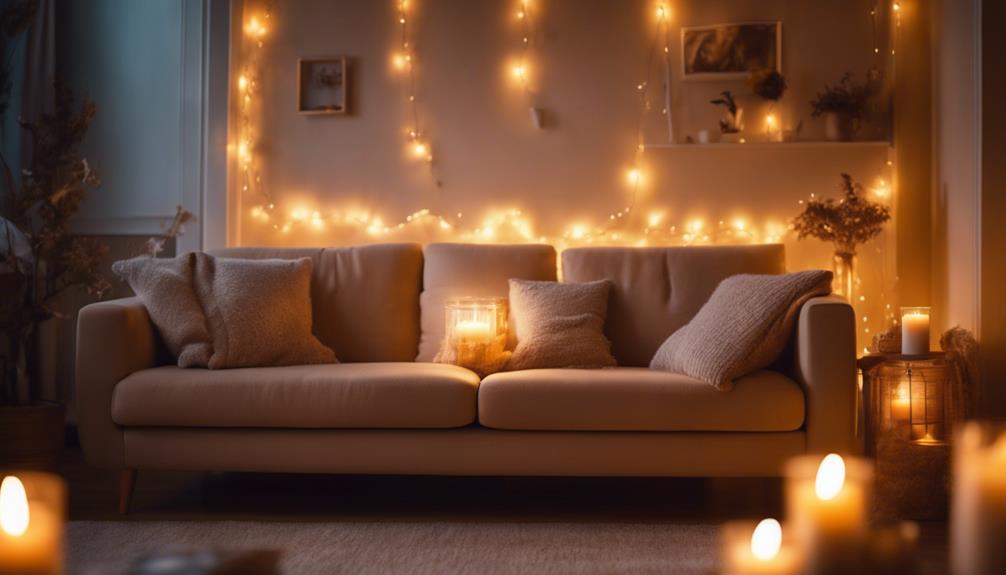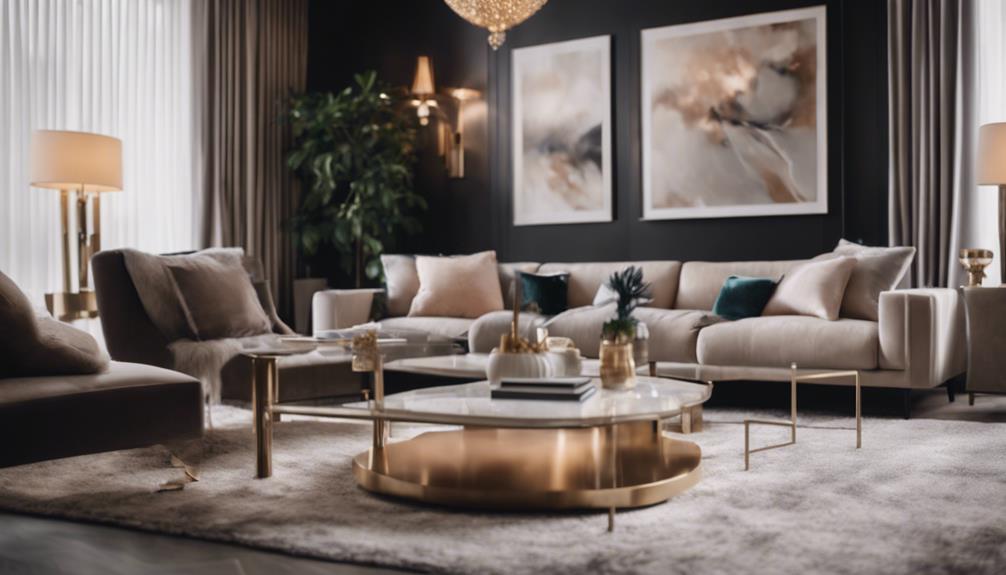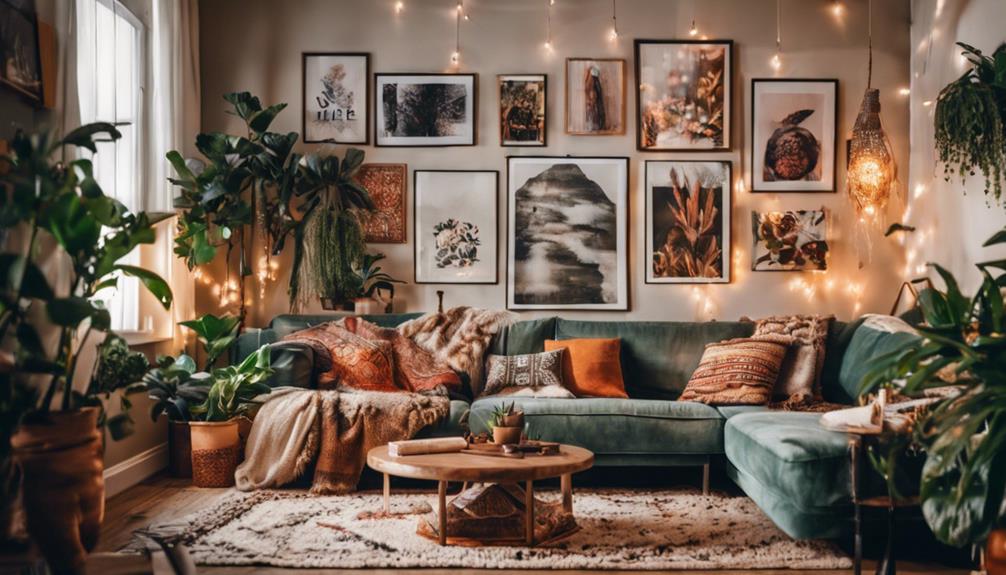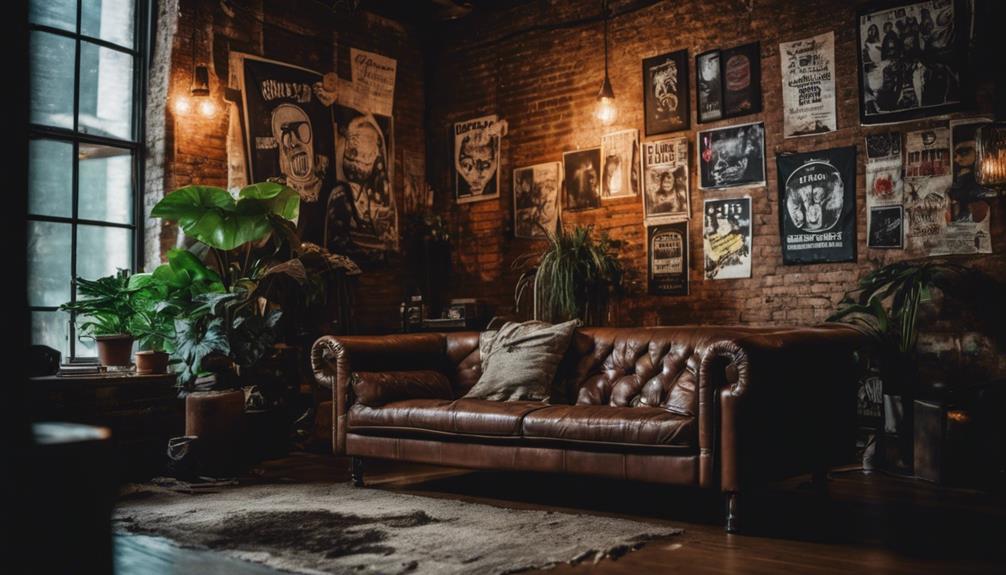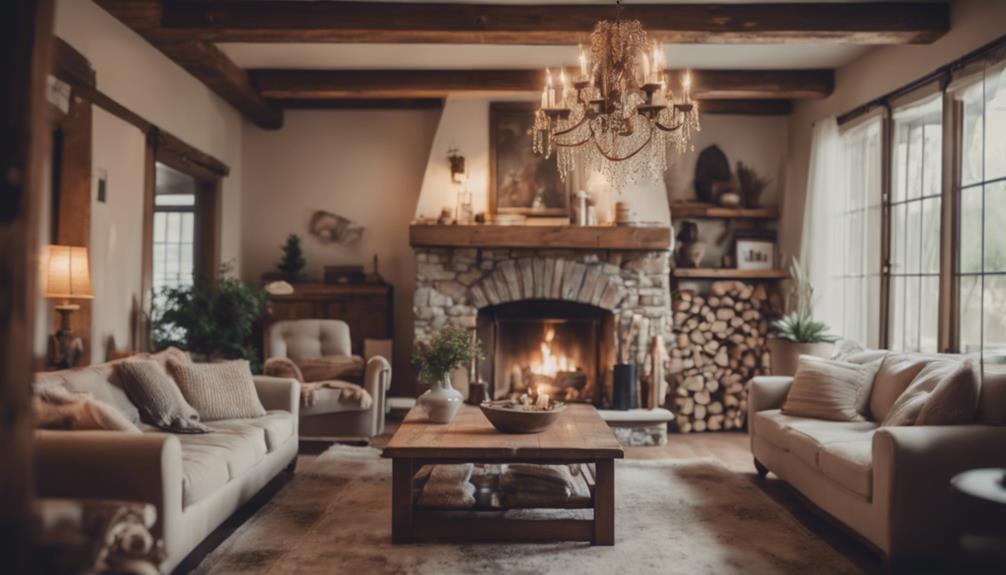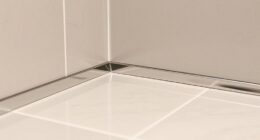You can easily revamp your bedroom for late summer with a few simple changes. Start by rejuvenating your bedding with lightweight, breathable fabrics in light colors and cheerful patterns. Enhance natural light using sheer curtains and strategically placed mirrors. Declutter to create a fresh, organized space, and add vibrant decor accents like colorful pillows and fresh-cut flowers. Incorporate low-maintenance indoor plants for a touch of greenery and improved air quality. Finally, optimize comfort by ensuring your room feels cool and cozy. Discover more ideas to transform your space and embrace the season fully.
Key Takeaways
- Refresh your bedding with lightweight fabrics and cheerful patterns to create a vibrant late summer atmosphere.
- Declutter your space by removing winter items and organizing essentials for a fresh, open feel.
- Enhance airflow and natural light with sheer curtains and strategically placed mirrors.
- Incorporate vibrant decor accents like colorful throw pillows and seasonal flowers for an uplifting look.
Refresh Your Bedding
To rejuvenate your bedding for late summer, swap out heavier covers for lightweight coverlet sets made from breathable fabrics that keep you cool at night. High-quality bed linen made from materials like cotton or bamboo promotes better airflow, ensuring you stay comfortable as temperatures rise.
When choosing your coverlets, opt for light colors and cheerful patterns that create a vibrant atmosphere, reflecting the essence of this revitalizing summer season. Incorporating bright hues not only brightens your space but also sets a joyful tone for your bedroom.
Machine-washable options are perfect for easy maintenance, allowing you to keep your bed looking fresh and clean throughout the season. Layer your bedding with decorative pillows and throws in complementary colors to add texture and visual interest while maintaining that light summer vibe.
Switching to lightweight coverlets and vibrant colors transforms your bedroom into a serene retreat, making it the perfect space to unwind after a long day.
Embrace the warmth of summer nights with bedding that's both functional and delightful, ensuring you get the restful sleep you need.
Embrace Natural Light
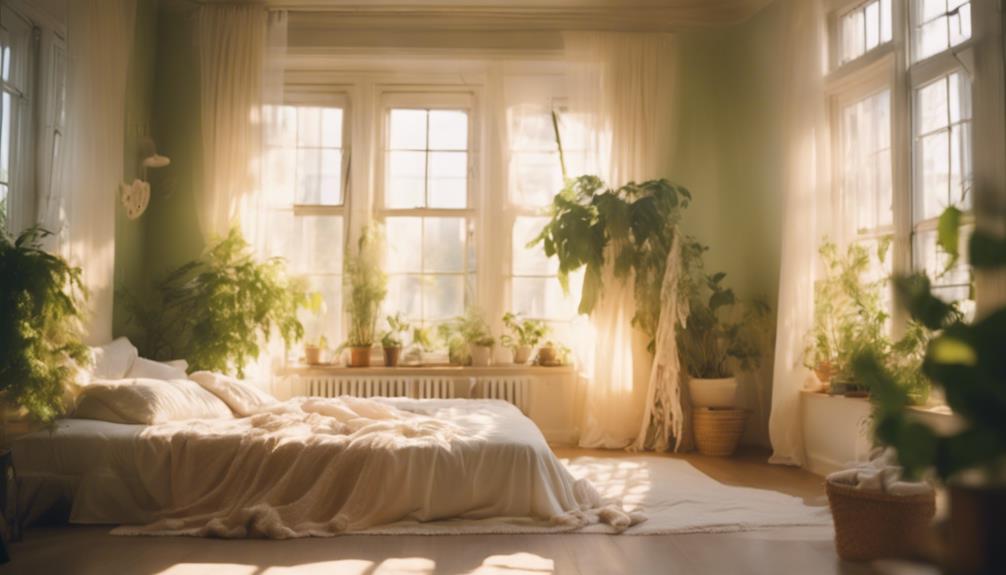
Enhancing your bedroom's ambiance with vibrant bedding naturally leads to embracing natural light, which can elevate your mood and create a revitalizing atmosphere.
To make the most of this, consider using light, sheer curtains that allow sunlight to filter in while still providing privacy. This helps establish a bright and airy atmosphere that feels inviting and cheerful.
Positioning mirrors opposite windows is another effective way to amplify natural light, reflecting it throughout the room and illuminating darker corners. This simple trick can markedly enhance the overall brightness of your space.
Additionally, don't forget about optimizing natural ventilation; opening your windows during cooler hours allows fresh air to circulate, reducing heat buildup and creating a comfortable environment.
Choosing light-colored window coverings not only deflects heat and sunlight but also gives your room a more spacious feel.
By incorporating these strategies, you can transform your bedroom into a serene retreat that embraces the beauty of natural light, enhancing your overall well-being.
Declutter for a Fresh Space
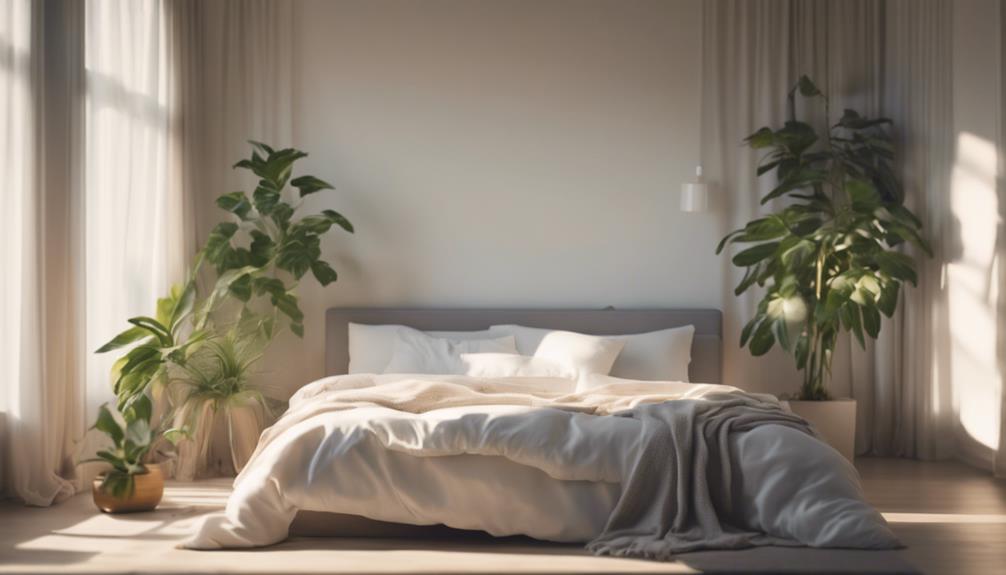
To refresh your bedroom for late summer, start by decluttering and removing heavy winter bedding and any items you no longer use.
Organizing your dressers and nightstands won't only enhance the room's look but also make it more functional.
A simpler space promotes serenity and helps create a more inviting atmosphere.
Essential Decluttering Techniques
Decluttering your bedroom can transform it into a fresh, inviting space that promotes relaxation and rejuvenation. Start by removing heavy winter bedding and any items you no longer use or need. This creates a lighter atmosphere, making your space feel more open.
Next, focus on your dressers and nightstands. Organize these areas by categorizing items and discarding or donating anything that doesn't serve a purpose. A tidy environment enhances the overall aesthetics of your room.
Implement a regular decluttering schedule, like seasonal cleanouts, to maintain an organized space and prevent the accumulation of unnecessary items. Consider utilizing storage solutions such as bins or baskets for smaller items, keeping everything neat and accessible. This way, your space becomes streamlined, allowing you to enjoy a tranquil atmosphere.
A clean and decluttered bedroom greatly contributes to a relaxing environment, improving your mental well-being and sleep quality. By committing to these essential decluttering techniques, you'll create an inviting space that encourages you to unwind and recharge, making your bedroom a true sanctuary.
Organizing for Serenity
Creating a serene bedroom starts with organizing your space to promote tranquility and comfort. Decluttering is key to achieving this atmosphere. Begin by clearing out heavy winter bedding and any unused items that clutter your room. This not only opens up physical space but also helps clear your mind, fostering a sense of freedom.
Next, focus on your dressers and nightstands. Organizing these areas reduces chaos and distractions, making it easier for you to unwind. A tidy environment contributes greatly to restful sleep, as it encourages a calming ambiance.
Establish a regular decluttering routine to maintain this serene space. Set aside time each week to evaluate what you really need and what can be donated or discarded. Adopting a minimalist approach simplifies your decor and enhances tranquility.
Add Vibrant Decor Accents
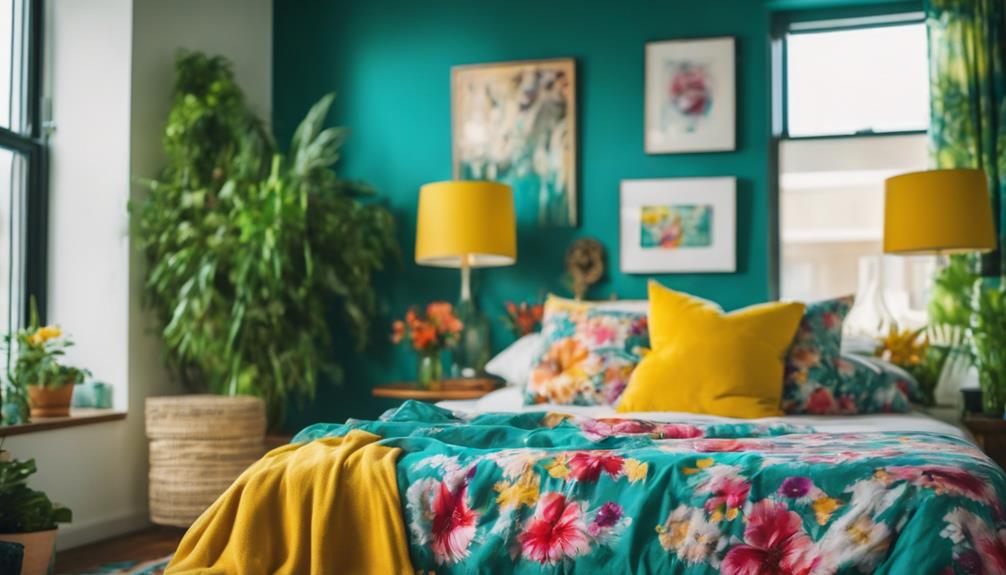
How can you transform your bedroom into a vibrant oasis? Start by incorporating vibrant decor accents that uplift the mood and create a cheerful atmosphere for late summer.
Consider introducing colorful throw pillows and blankets that pop against your existing color palette. Embrace shades of emerald green, coral, or sunny yellow to reflect the vibrant energy of the season.
To enhance visual interest, mix textures like velvet and woven materials, adding depth and warmth to your space. Swap darker decor for lighter, brighter pieces to maintain a fresh, airy feel. This not only invites positivity but also makes the room more inviting during those warm summer months.
You don't have to break the bank for seasonal updates. Shop at local thrift stores or take on DIY projects to find unique items that resonate with your style.
Each vibrant accent you add personalizes your bedroom decor and creates a space where you can relax and recharge. By embracing these ideas, your bedroom won't only look amazing but also feel like a true reflection of late summer's lively spirit.
Incorporate Summer Plants
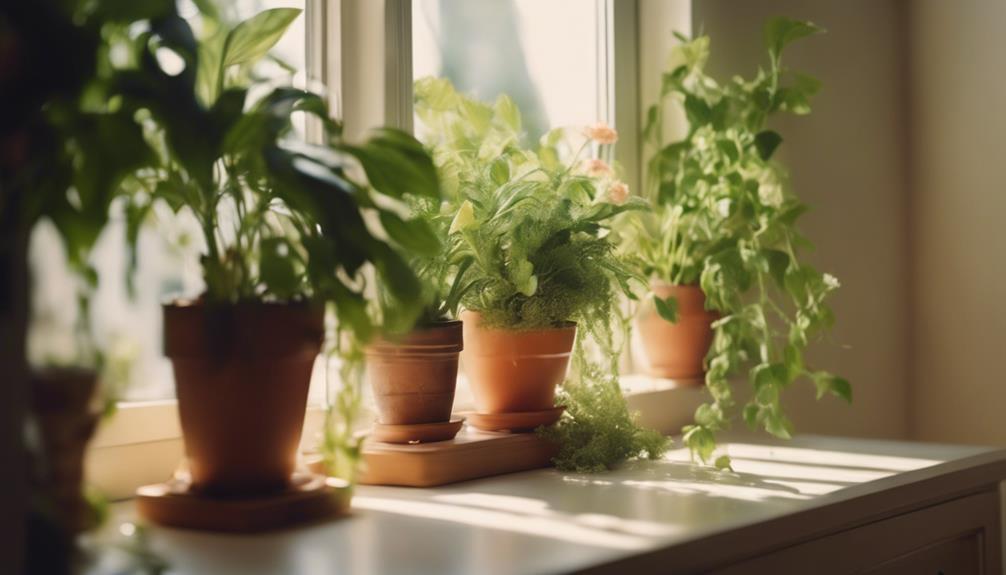
Incorporating summer plants into your bedroom can transform the space while boosting air quality and adding vibrant colors.
By choosing low-maintenance varieties, you can enjoy the benefits without the hassle of constant care.
Plus, the right plants can brighten up your room and create a rejuvenating atmosphere perfect for late summer relaxation.
Choose Low-Maintenance Varieties
Choosing low-maintenance houseplants like snake plants and pothos can effortlessly enhance your bedroom's summer vibe while improving air quality. These low-maintenance varieties are perfect for anyone looking to add some greenery to their summer decor without the stress of constant upkeep.
Snake plants thrive in low light and only need watering every few weeks, making them an ideal choice for busy lifestyles. Pothos, on the other hand, can handle a bit of neglect and flourishes in indirect sunlight.
If you're aiming for a fresh look without the commitment of potted plants, consider adding fresh-cut flowers like sunflowers or daisies. They can bring a burst of seasonal vibrancy to your space and brighten your mood, all while requiring minimal effort.
Incorporating these houseplants or floral arrangements creates a calming atmosphere that promotes relaxation. You don't have to worry about intricate care routines; instead, you can enjoy the beauty and benefits of greenery without the hassle.
Enhance Air Quality
Elevate your bedroom's air quality by adding summer plants that filter toxins and boost oxygen levels, creating a healthier environment for relaxation. Incorporating houseplants like snake plants and pothos can greatly improve your indoor air quality, making your summer bedroom a rejuvenating oasis. These plants effectively remove harmful toxins while releasing oxygen, contributing to your overall well-being.
Consider adding spider plants, known for their ability to eliminate pollutants like formaldehyde and xylene. By doing so, you'll create a cleaner atmosphere that fosters a tranquil environment, ideal for reducing stress and improving your mood. Plus, the presence of greenery not only enhances your space but also promotes restful sleep.
Choose low-maintenance plants that thrive in low-light conditions to guarantee your bedroom remains vibrant without requiring extensive care. Fresh cut flowers can also be an excellent addition; they introduce natural scents that elevate mood and create a calming ambiance.
Brighten Your Space
Bring your bedroom to life by adding vibrant summer plants that not only brighten your space but also purify the air. Incorporating plants like snake plants, pothos, and spider plants can transform your bedroom into a rejuvenating oasis filled with lush greenery and bright colors.
These low-maintenance options thrive indoors, making it easy for you to enjoy their benefits without excessive care.
Fresh cut flowers are another fantastic choice, infusing your room with color and natural beauty while requiring minimal upkeep. The striking hues of summer blooms can instantly make your space feel brighter and more inviting.
Plus, houseplants improve air quality by filtering harmful pollutants, which enhances your overall health and well-being.
Create a Relaxing Atmosphere
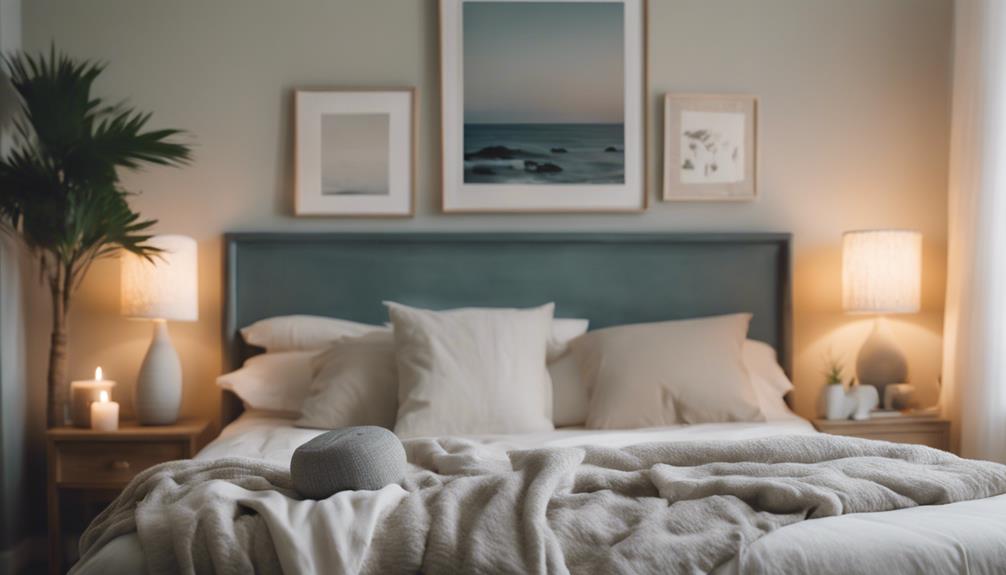
To create a relaxing atmosphere in your bedroom, consider incorporating essential oils like lavender or eucalyptus, which can greatly enhance your overall sense of calm and well-being. These scents not only promote relaxation but also help reduce stress, making them perfect for encouraging restful sleep.
Next, think about adding some greenery. Houseplants or fresh flowers can beautify your space while also purifying the air, contributing to a tranquil environment. The presence of nature can work wonders in promoting relaxation.
When it comes to lighting options, opt for soft, warm lighting through lamps or string lights. This approach helps to minimize the harshness of overhead lights, creating a cozy atmosphere that invites you to unwind. Avoid bright, cold lights that can disrupt your sense of peace.
Lastly, consider implementing noise-blocking strategies to further enhance your bedroom's serenity. Soundproofing or using white noise machines can create a quiet haven, making it easier for you to drift off into a deep, restful sleep. By focusing on these elements, you'll successfully create a relaxing atmosphere in your bedroom.
Optimize Cooling Features
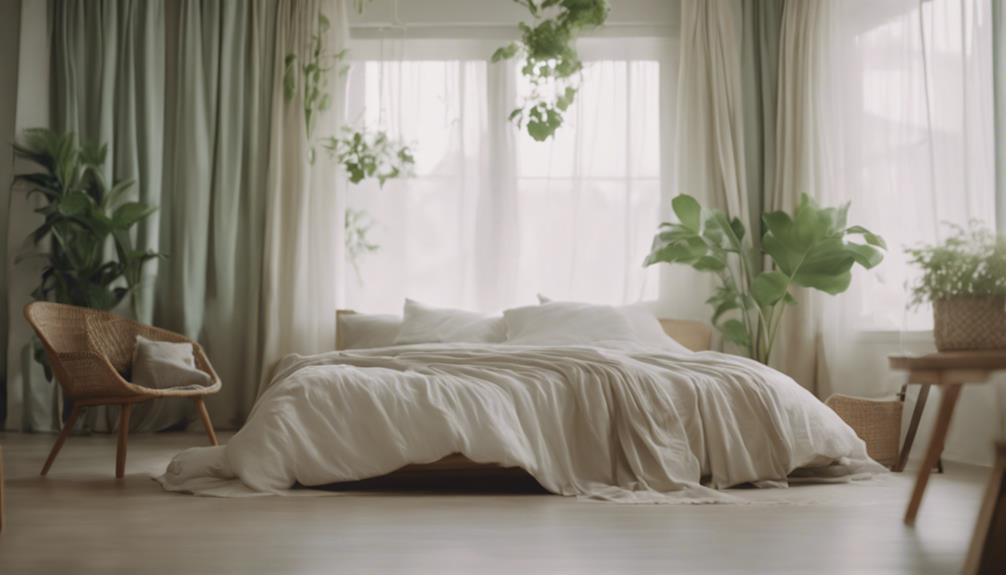
Creating a calming bedroom atmosphere sets the stage for optimizing cooling features that guarantee your comfort during warm summer nights.
Start by investing in cooling mattresses, such as those with gel-infused foam, which help regulate your body temperature and enhance airflow for a more restful sleep.
Next, select breathable fabrics for your bedding like bamboo or linen. These materials promote air circulation and reduce heat retention, keeping you cool and comfortable throughout the night.
To further enhance your bedroom's cooling effect, consider these simple strategies:
- Install light-colored window treatments that deflect heat and sunlight, helping to maintain a cooler room temperature.
- Utilize fans strategically to create a gentle breeze, promoting better air circulation and reducing stuffiness.
Personalize Your Space
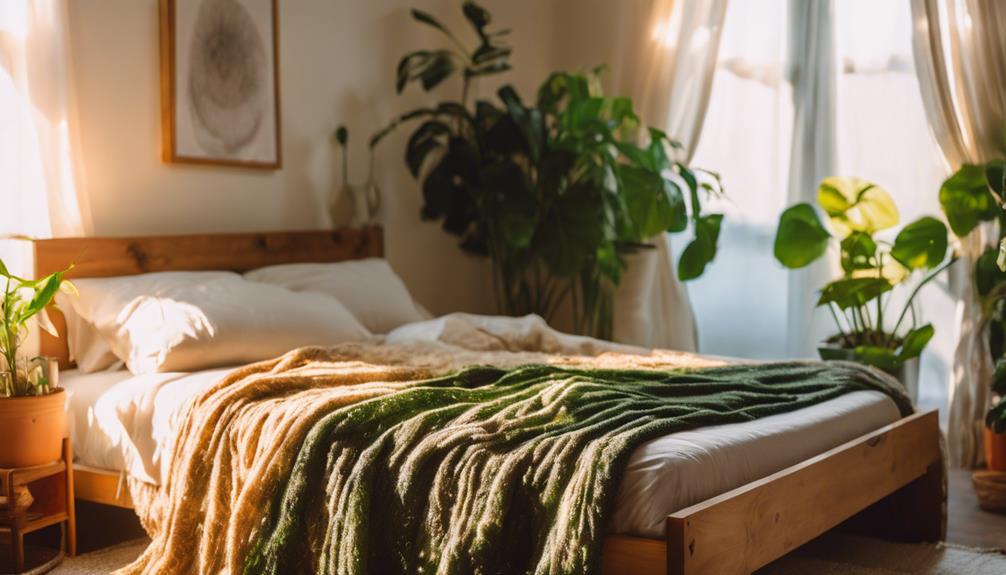
Personalizing your space transforms your bedroom into a reflection of your unique style and interests. Start by selecting wall art that resonates with you, whether it's vibrant prints or cherished photographs. Themed bedding adds a fun touch, allowing you to express your personality while enhancing comfort. Consider incorporating vintage finds to give your bedroom makeover a charming, eclectic feel.
Involve family members in the process; let them share their thoughts on colors, furniture, and layout. This collaboration not only strengthens relationships but also makes the outcome more enjoyable and inclusive.
Don't shy away from using removable decor items and modular shelving, as they allow for easy updates that accommodate your evolving tastes.
Documenting your transformation journey is also important. Capture each step, from brainstorming ideas to the final reveal, creating lasting memories of your creative process.
Frequently Asked Questions
What Would You Do to Transform a Bedroom?
To transform your bedroom, declutter your space, swap heavy bedding for lightweight options, add fresh greenery, choose airy window treatments, and incorporate colorful pillows. These changes create a rejuvenating, inviting atmosphere perfect for summer.
How Can I Make My Bedroom Look Amazing?
Did you know that a well-decorated bedroom can improve sleep quality by up to 30%? You can make your bedroom look amazing by using breathable fabrics, vibrant colors, and adding natural elements like plants for freshness.
How to Give Your Room a Makeover for Free?
To give your room a makeover for free, rearrange furniture, declutter, swap seasonal decor, and engage in DIY projects using materials you already have. Collaborate with friends for fresh ideas and exchange decorative items for a new look.
How to Modernise a Bedroom?
To modernize your bedroom, incorporate multi-functional furniture, choose a neutral palette with vibrant accents, and embrace minimalist decor. Invest in smart technology and update window treatments for a fresh, spacious, and tech-savvy atmosphere.
Conclusion
Revamping your bedroom for late summer doesn't have to be overwhelming.
In fact, a well-organized space can boost your mood by 20%!
By revitalizing your bedding, embracing natural light, and adding vibrant decor, you'll create a haven that feels both inviting and relaxing.
Incorporate summer plants and cool features to enhance comfort, and don't forget to personalize your space.
With these simple changes, you'll transform your bedroom into a revitalizing retreat that you'll love to unwind in.
